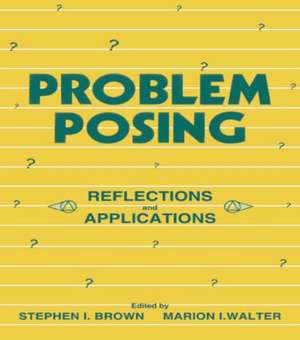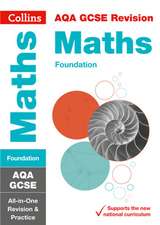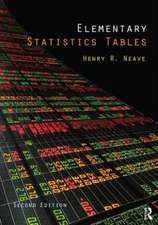Problem Posing: Reflections and Applications
Editat de Stephen I. Brown, Marion I. Walteren Limba Engleză Paperback – mar 1993
Based in part upon that work and also upon a number of articles by its authors, other members of the mathematics education community began to apply and expand upon their ideas. This collection of thirty readings is a testimony to the power of the ideas that originally appeared. In addition to reproducing relevant materials, the editors of this book of readings have included a considerable amount of interpretive text which places the articles in the context of problem solving. While the preponderance of essays focus upon mathematics and mathematics education, some of them point to the relevance of problem posing to other fields such as biology or psychology. In the interpretive text that accompanies each chapter, they indicate how ideas expressed for one audience may be revisited or transformed in order to ready them for a variety of audiences.
Preț: 245.13 lei
Preț vechi: 461.39 lei
-47% Nou
Puncte Express: 368
Preț estimativ în valută:
46.90€ • 49.10$ • 38.81£
46.90€ • 49.10$ • 38.81£
Carte tipărită la comandă
Livrare economică 05-19 aprilie
Preluare comenzi: 021 569.72.76
Specificații
ISBN-13: 9780805810653
ISBN-10: 080581065X
Pagini: 354
Dimensiuni: 152 x 229 x 23 mm
Greutate: 0.65 kg
Ediția:New.
Editura: Taylor & Francis
Colecția Psychology Press
Locul publicării:Oxford, United Kingdom
ISBN-10: 080581065X
Pagini: 354
Dimensiuni: 152 x 229 x 23 mm
Greutate: 0.65 kg
Ediția:New.
Editura: Taylor & Francis
Colecția Psychology Press
Locul publicării:Oxford, United Kingdom
Public țintă
ProfessionalCuprins
Contents: Preface. Introduction. Part I: Reflections. Section 1: Pedagogical Focus: The Design of a Course. S.I. Brown, M.I. Walter, In the Classroom: Student as Author and Critic. S.I. Brown, M.I. Walter, Problem Posing in Mathematics Education. Section 2: Elaborations and Applications of Problem Posing Schemes. E.P. Goldenberg, On Building Curriculum Materials That Foster Problem Posing. D.S. Fielker, Removing the Shackles of Euclid: 8 "Strategies". W. Feibel, "What if Not?" A Technique for Involving and Motivating Students in Psychology Courses. Section 3: Rationale: Towards a Multiplistic View of the World. J.R. Jungck, A Problem Posing Approach to Biology Education. D. Buerk, An Experience with Some Able Women Who Avoid Mathematics. R. Borasi, The Invisible Hand Operating in Mathematics Instruction: Student's Conceptions and Expectations. S.I. Brown, The Logic of Problem Generation: From Moraltiy and Solving to De-Posing and Rebellion. I. Scheffler, Vice into Virtue, or Seven Deadly Sins of Education Redeemed. Part II: Algebra and Arithmetic. Section 1: Asking Why. D.J. Whitin, Number Sense and the Importance of Asking "Why?" M. Small, Creating Number Problems. D. Brutlag, Making Your Own Rules. R.N. Blake, 1089: An Example of Generating Problems. Section 2: Mistakes. L.N. Meyerson, Mathematical Mistakes. R. Borasi, Algebraic Explorations of the Error 16/64 = 1/4. Section 3: Tinkering With What Has Been Taken For Granted. W.S. Bush, A. Fiala, Problem Stories: A New Twist on Problem Posing. S.I. Brown, How to Create Problems. B.M. Moses, E. Bjork, E.P. Goldenberg, Beyond Problem Solving: Problem Posing. B.V. Kissane, Mathematical Investigations: Description, Rationale, and Example. M. Walter, Curriculum Topics Through Problem Posing. A. Friedlander, T. Dreyfus, Is the Graph of y = kx Straight? Section 4: Your Turn. C. Cassidy, B.R. Hodgson, Because a Door Has To Be Open or Closed, An Intriguing Problem Solved by Some Inductive Exploration. Part III: Geometry: Editors' Comments. Section 1: Looking Back. L. Sowder, The Looking-Back Step in Problem Solving. D.L. Jones, K.L. Shaw, Reopening the Equilateral Triangle Problem: What Happens If... S.I. Brown, Mathematics and Humanistic Themes: Sum Considerations. Section 2: The Intertwine of Problem Posing and Problem Solving. L. Hoehn, Problem Posing in Geometry. D. Chazan, Students Microcomputer-Aided Exploration in Geometry. Section 3: Something Comes From Nothing. M. Walter, Generating Problems From Almost Anything. Section 4: Your Turn. P.A. Schmidt, A Non-Simply Connected Geoboard-Based on the "What If Not" Idea.
Recenzii
"This book will be a valuable resource for any teacher at any level who is committed to teaching students not only to solve problems, but also to pose them....This book could be an important aid in helping us decide what sort of mathematics classrooms we want to have. Its ideas deserve to be understood and evaluated by all concerned with mathematics education....It can be strongly recommended not only for teachers of all abilities and at all levels, but also for members of school councils and those industrialists who are becoming increasingly vocal about what should be going on in our schools."
—Australian Mathematics Teacher
"...thought-provoking reference....Problem Posing is an infectious idea; both teachers and students need to be exposed to it....highly recommended..."
—Mathematics Teacher
"Excellent text for pre-service or in-service teachers."
—American Mathematical Monthly
—Australian Mathematics Teacher
"...thought-provoking reference....Problem Posing is an infectious idea; both teachers and students need to be exposed to it....highly recommended..."
—Mathematics Teacher
"Excellent text for pre-service or in-service teachers."
—American Mathematical Monthly
Notă biografică
Stephen I. Brown, Marion I. Walter
















